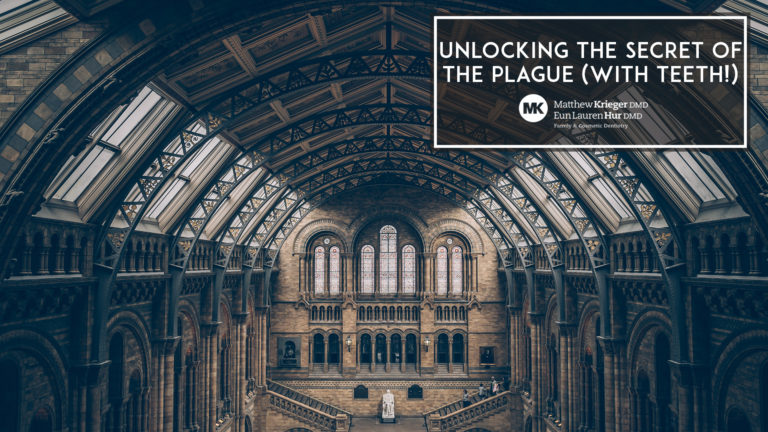It seems like every day there’s a new celebrity sporting a diamond in their teeth or a decorative gold grill. While it might seem like a new fad amongst the high-fashion elite or those searching for Instagram stardom, cosmetic dental adornments are anything but. In fact, enhancing teeth with precious gems, metals and more has a long history — and one we’d be wise to learn from when it comes to the risks and downsides of having a blinged-out smile.
Dating back to the Tuscan region of Italy from about 800 BCE to 200 BCE, the Etruscans would weave together teeth with gold wire no thicker than a rubber band. The earliest extant example of such a tooth adornment dates to 7 BCE — belonging to a wealthy Etruscan woman whose very healthy teeth were purposefully removed so she could have them welded together with gold bands. It wasn’t a dentist who performed the work, either — ancient grills were solely the work of goldsmiths.
From about 300 CE to 900 CE, the Mayans ruled an empire in what now encompasses Mexico and parts of Central America. Kings, queens and other nobility would purposefully drill holes up to 3mm wide in their teeth and fill them with jade. The lighter colored the jade, the wealthier the wearer. The gems were worn as a statement that they were responsible for life-giving rains, fertile crops and ensuring their people were fed and prosperous. While it may have served to enhance the wearer’s appearance, it was seen as a much more profound statement than just fashion.
While it may be tempting to save a few bucks by seeking out DIY solutions to enhance your smile, it’s a job best left to the pros. And one of the first steps you should take if you’re considering glitzy, blinged-out teeth is to ensure the health of your mouth.
The office of Drs. Krieger and Hur can book you for an exam and cleaning to ensure your mouth is in the best shape possible. You can snag your spot by giving us a call at (201) 560-0606. Since we know you lead a busy life, you can also secure your appointment time by sending us an email by clicking here. While we can’t promise you a blinged-out smile when you leave our chair, we’ll do our best to make your smile shine.
Etruscan Grills
While a dubious internet search might pull up claims that the Egyptians were the first to sport grills — gold or silver metal implants, dentures or facades — it was actually the Etruscans we have to thank for this phenomenon.Dating back to the Tuscan region of Italy from about 800 BCE to 200 BCE, the Etruscans would weave together teeth with gold wire no thicker than a rubber band. The earliest extant example of such a tooth adornment dates to 7 BCE — belonging to a wealthy Etruscan woman whose very healthy teeth were purposefully removed so she could have them welded together with gold bands. It wasn’t a dentist who performed the work, either — ancient grills were solely the work of goldsmiths.
Mayan Tooth Gems
Tooth gems have been called out by social activists as a form of cultural appropriation, but it hasn’t stopped front-page celebrities from getting them. Wearing gems on your teeth isn’t a passing fad or trend — it’s long been a part of Latino culture, dating back to the earliest documented examples in the Mayan Empire.From about 300 CE to 900 CE, the Mayans ruled an empire in what now encompasses Mexico and parts of Central America. Kings, queens and other nobility would purposefully drill holes up to 3mm wide in their teeth and fill them with jade. The lighter colored the jade, the wealthier the wearer. The gems were worn as a statement that they were responsible for life-giving rains, fertile crops and ensuring their people were fed and prosperous. While it may have served to enhance the wearer’s appearance, it was seen as a much more profound statement than just fashion.
Gold Teeth: A Global Phenomenon
While grills and tooth gems have a definitive place and time in history they can be traced to, gold teeth seem like a more universal phenomenon. Early examples of gold being used as a filling or replacement material exist in every culture that had access to the metal. From the Philippines to China, the Mayan Empire to the Vikings, every culture that could use gold as a way to modify teeth has done so. It’s likely that as soon as humans became interested in preserving their teeth or modifying them for cosmetic appearances, they started looking for materials with which to do so. Because gold is widespread and one of the more malleable metals, it makes sense that gold teeth, caps and fillings would appear across the globe and throughout history.Considering Blinging Out Your Smile?
While we no longer pull healthy teeth to insert grills or have to drill holes to set tooth gems, these cosmetic dental enhancements are not without risk. Now secured with long-lasting adhesives, they provide the perfect breeding ground for the bacteria that cause plaque buildup and decay. The adhesives themselves, when improperly applied or removed, can cause structural damage to your smile.While it may be tempting to save a few bucks by seeking out DIY solutions to enhance your smile, it’s a job best left to the pros. And one of the first steps you should take if you’re considering glitzy, blinged-out teeth is to ensure the health of your mouth.
The office of Drs. Krieger and Hur can book you for an exam and cleaning to ensure your mouth is in the best shape possible. You can snag your spot by giving us a call at (201) 560-0606. Since we know you lead a busy life, you can also secure your appointment time by sending us an email by clicking here. While we can’t promise you a blinged-out smile when you leave our chair, we’ll do our best to make your smile shine.


